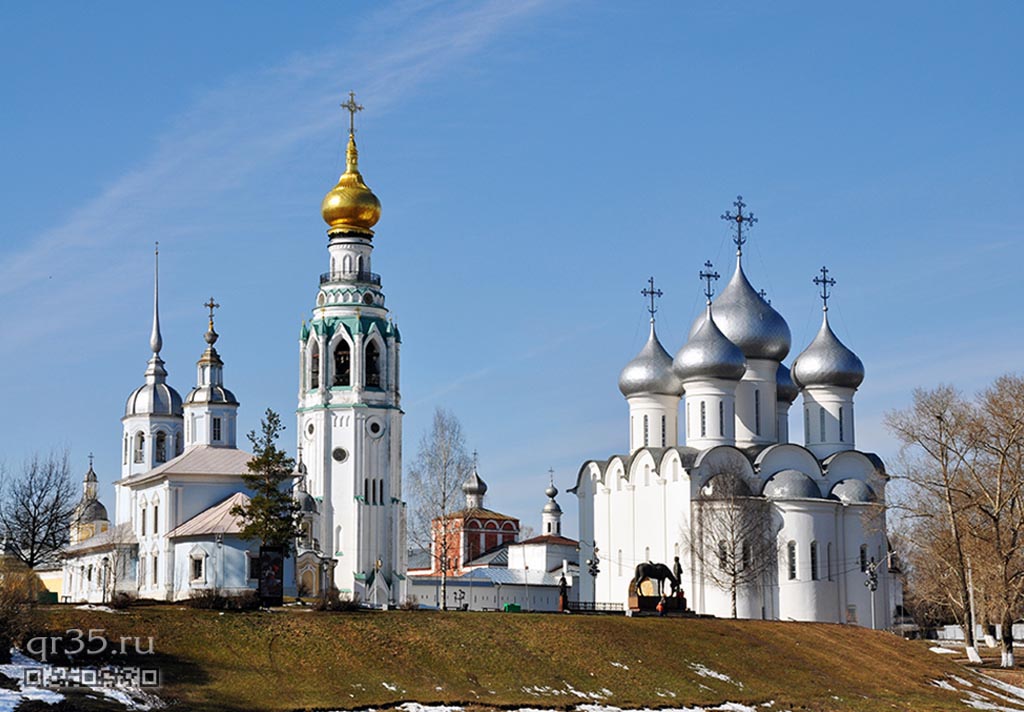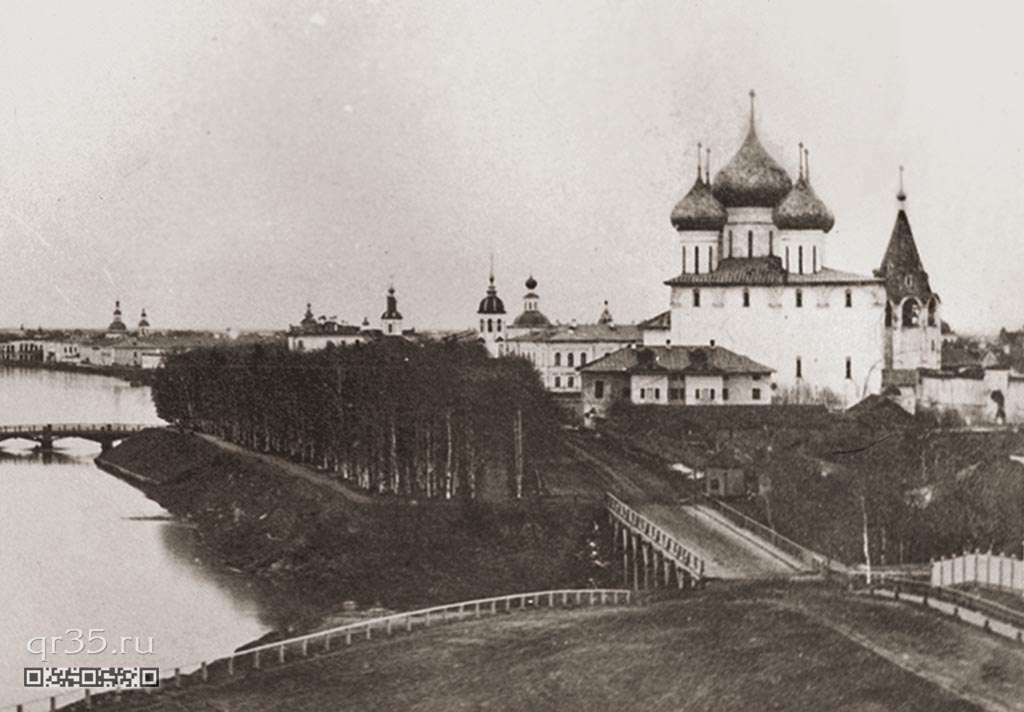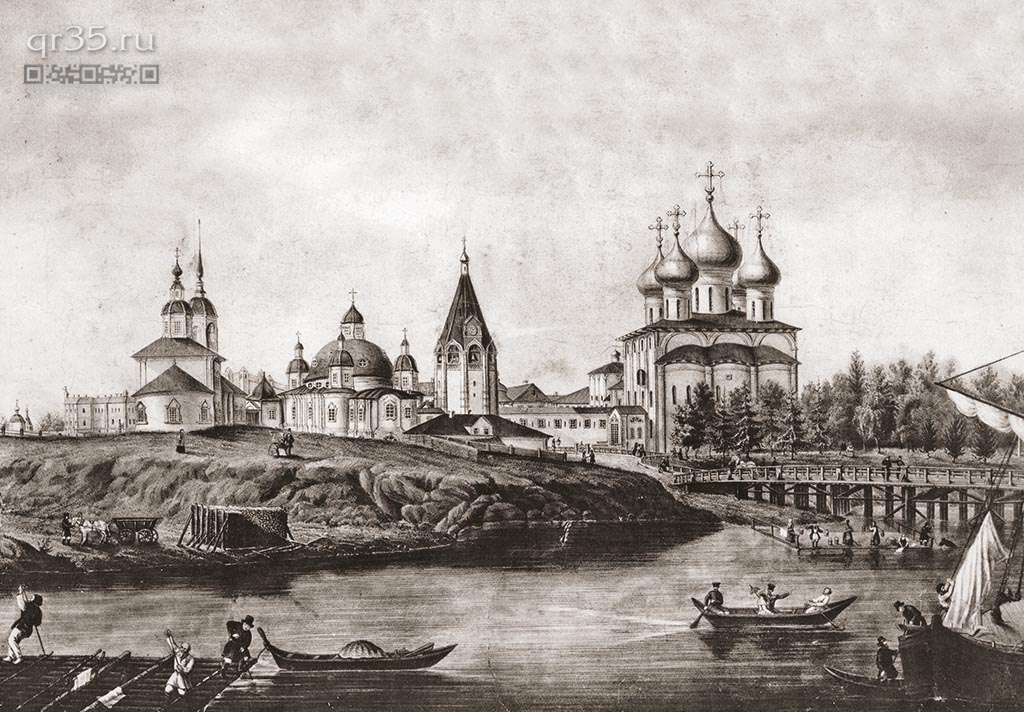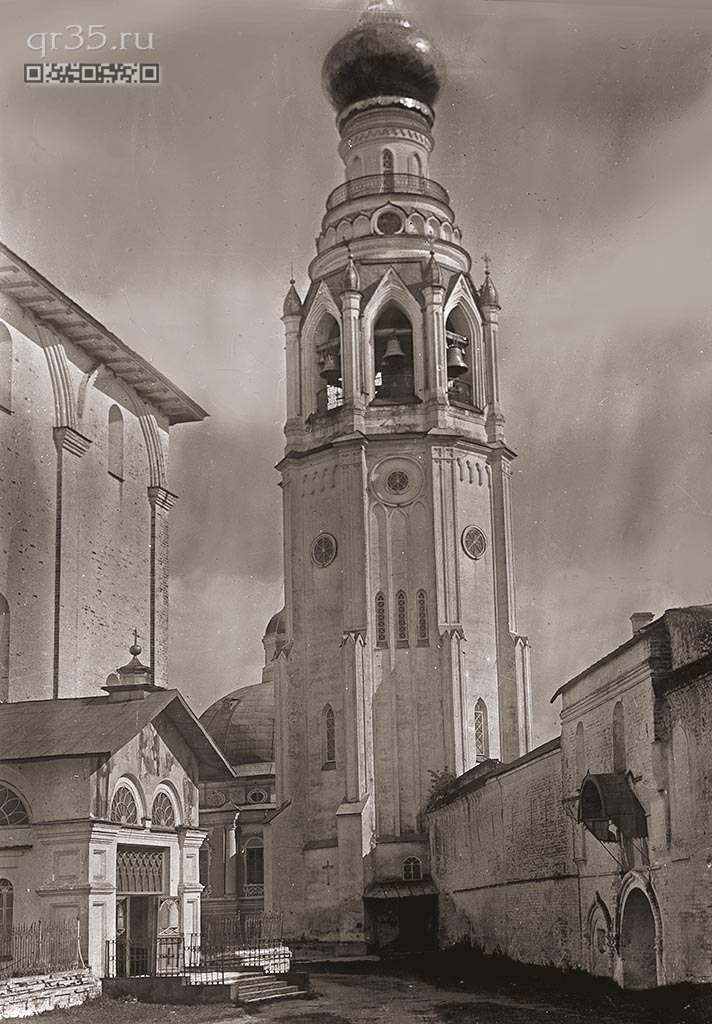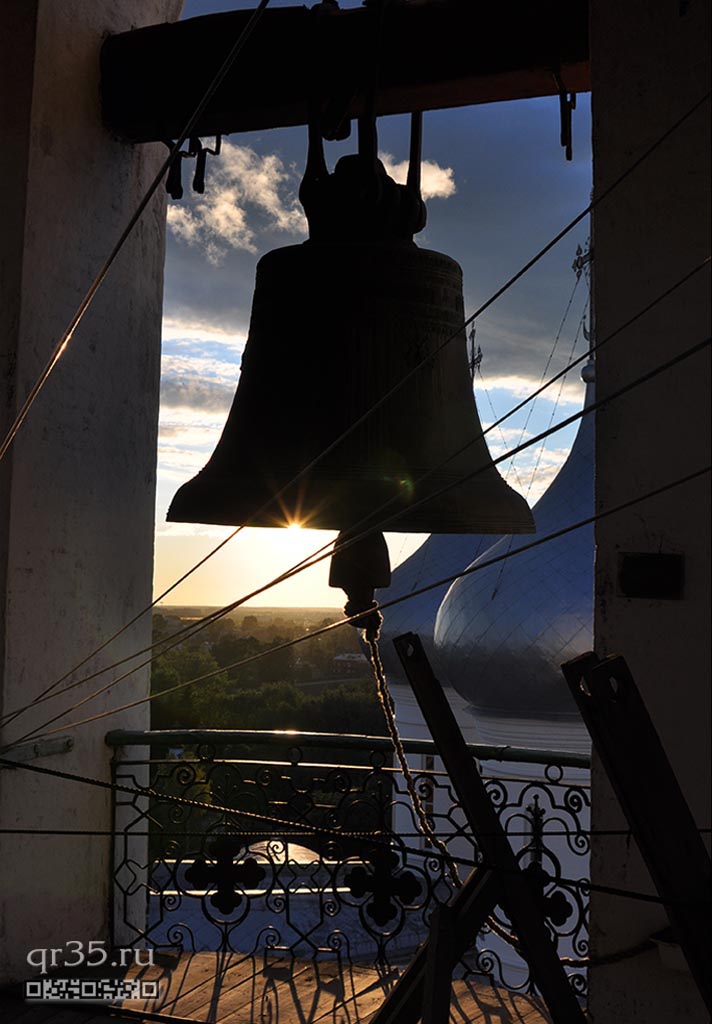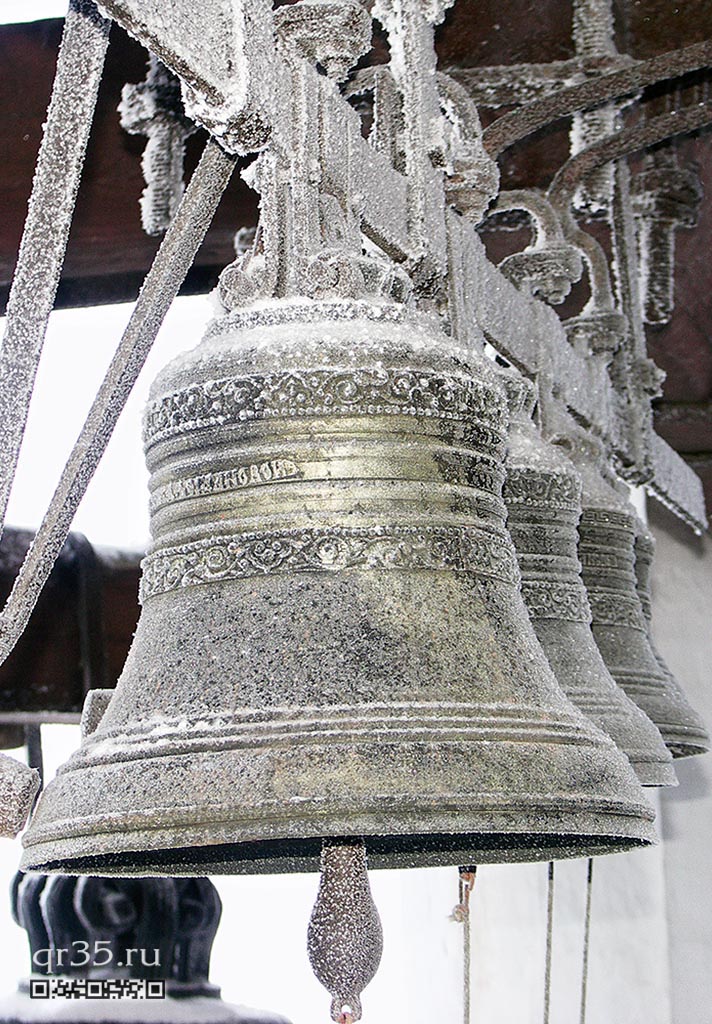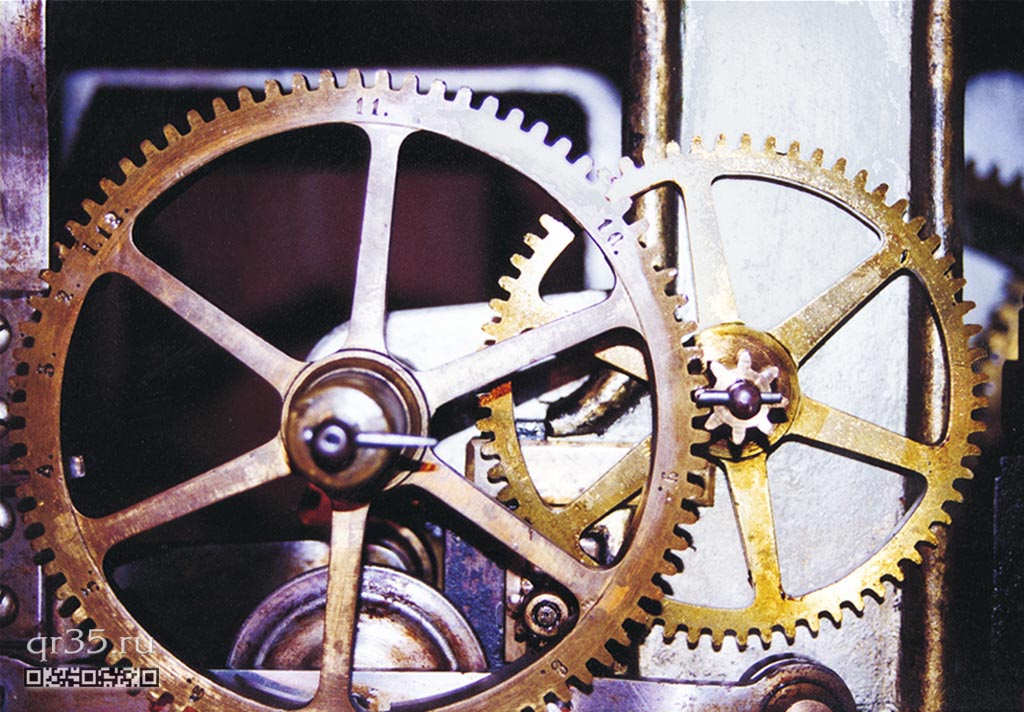Belfry of St. Sophia Cathedral
GENERAL INFORMATION
Dating: 1869-1870.
Type: A monument of architecture.
Status: a cultural heritage site of federal importance.
State protection registration document: Authorization of the Council of Minsters of RFSFR No. 1327, August 30, 1960; Decree of the President of the Russian Federation No. 176, February 20, 1995.
Address: 15 Orlova St., Vologda, Russia.
Authorship: A. I. Ivanitsky.
An ensemble: Vologda Kremlin (Archbishop’s Court).
Brief description.
The Belfry is a vertical dominant of Vologda historical center. Its height is 73 m. 25 bells of 17-19th centuries are preserved. The chiming clock is installed on the Belfry.
Condition: satisfactory.
Contemporary use: It is used by Vologda State Museum-Reserve as a tourist site.
HISTORY
Wooden Belfry
The bell tower must have existed by the time of the consecration of the cathedral, but the first wooden hipped belfry of St. Sophia Cathedral was mentioned only in 1622, "some carpenters were hired... and a wooden belfry of eight walls was being built". In addition to 11 bells it had a quite rare in those days in Russia curiosity - a clock. The fire, which destroyed or damaged structures of the Archbishop's house in 1636, did not spare the bell tower either, and instead a temporary structure was put up: "the pillars were set up".
In 1641 a new belfry was built, a few more bells were hoisted on it and a new clock was installed- "chimes striking quarters" - which had a "face" and struck quarters of an hour. In 1653, Archbishop Markel in his petition to the Russian tsar gave the following description of the state of this structure: "and the wooden bell tower, Sir, is dilapidated, and logs of the walls are going out", and asked for permission to use the stones, stored up for the unfinished fortress of Ivan the Terrible, to build a new stone belfry.
The First Stone Belfry
After the tsar’s approval the first stone bell tower was erected in 1654-1659. A high eight-faced pillar with pilaster-strips and an open upper tier of the belfry was capped with a slender tent with a small cupola. And of the "Kirillov monastery elder Michael repaired the chiming clock, ...and made the clock face and connected chimes to the bells". The great bell, the evangelist, beat each hour, and six smaller bells - quarters of an hour. In 1698, the bell tower damaged by a lightning strike, the burnt roof and cupola were soon restored. But for about twenty years it was not possible to fix the tent: a lot of Vologda artisans were mobilized for construction sites and shipyards by Peter the Great, and besides there was lack of funds. Since then, ministers have repeatedly stated that "from the sound of the bells bricks are falling down and therefore there’s danger of big collapse".
The Construction of the Existing Bell Tower
In 1868, in preparation for the celebration of the 300th anniversary of St. Sophia Cathedral Bishop Paul decided to heighten the belfry, which, in the opinion of its contemporaries "did not conform to the dignity of other buildings". The provincial architect A. I. Ivanitsky worked out a measurement drawing of the old bell tower and at least two projects of its reconstruction (one of them, "in ancient taste", where the belfry resembles Moscow Ivan the Great Bell Tower, is known). In 1869-1870 the same A. I. Ivanitsky (but not his successor at a position at that moment V.N. Shildkneht as previously believed) implemented the project of reconstruction of the Belfry in pseudo-Gothic style. Though in the composition and certain details of the structure architectural trends of Ancient Russia can be seen. The upper part of the bell tower (the tent and the pillars of the bell tier) were dismantled, and on the basis (pillar) strengthened by buttresses a new upper part was overbuilt, which was higher than the former one by 15 fathoms (32 meters).
The Clock
With the money of the citizens V.A. Zasetskaya and A. P. Nabalova new chimes were purchased in Moscow in the firm «Butenop Brothers », and then installed in 1871.
In 1967 the stopped because of worn parts mechanism was restored by the Vologda museum watchmaker V.A. Korol’kov and the foreman of mechanics of the plant «Severny Kommunar» B. N. Sosin. Since 1968, every ten years the main mechanism of the clock is fully disassembled, some of its details are washed and polished.
The main mechanism of the Vologda chimes consists of three winding mechanisms: one - for running the clock hands (running), another - for the striking of the clock, and the third one – for beating quarters of an hour.
The mechanisms are in a closed room in the center of the bell tower, between the belfry tier and the observation deck. In the heart of the clock mechanism there is the Graham course, consisting of an escape wheel with 30 teeth and an anchor, connected to a pendulum with the help of a fork. At the ends of the anchor curved inside cylindrical pallets are fixed with plates and screws – an entry plaque and an exit plaque. The chassis weight is 8 poods. To the right of the chassis there is a mechanism of quarters which beats every 15 minutes in a special way. It is driven with the 9-pood weight. When the last quarter is beaten, the leverage goes to the clock striking mechanism on the left of the chassis. The chimes are produced with the help of the 12 - pood weight, connected to the striking mechanism and the hour bell. From the escape wheel a shaft goes upwards, which has a transfer on four shafts going to dial mechanisms. The chimes are winded by hand every three days with a margin of 8 hours.
Bells
In 1701, when according to the decree of Emperor Peter I bells all over Russia were being documented to withdraw the fourth part of «bell copper» on military needs, the Cathedral's bell tower had 22 bells weighing 1039 poods 5 pounds in total [6]. The fourth part of the weight of St Sofia’s bells was 259 p. 31 f. with a quarter, but none of the bells of the bell tower was taken down. In February 1701, 2 broken bells weighing 46 poods 3 pounds, 181 poods 26 pounds of red caldron copper and 32 poods 2 pounds and a quarter of pure English rod tin on 22 carts were sent to Moscow Cannon Yard. "And over that quarter 200 poods of red caldron copper are sent for addition." And in March 1702, following the star’s deed with a «gracious word» two bells were delivered to Vologda: one weighing 176 pood 20 pounds, the other - 23 poods 6 pounds [8].
The bigger of those bells is known today as Big Swan, it was cast by a famous master Ivan Motorin – the creator of the Tsar Bell. So zeal of Archbishop Gabriel contributed to the decoration rather than destruction of the Vologda cathedral bell tower.
A number of bells have names: Big (aka Festive, cast in 1687 in Lubeck, weighing 462 poods 23 pounds), Archangel (aka Jubilee, cast in 1869 in Kadnikov District of Vologda province by master S. D. Chatyshnikov weighing 302 poods 29 pounds), Big Swan (cast in 1691/92 by master I.F.Motorin, weighing 176 poods 20 pounds), Small Swan (cast in 1756 in Vologda district by master M. A. Kolokolnikov, weighing 100 poods), Clock (cast in 1627 in Amsterdam), Vozdvyzhensky (aka Vsednevnyy, cast in 1739 in Vologda District by master I. K. Sokharev, weighing 223 poods).
As an example, we will present the published by N. I. Fedyshin (and earlier with gaps – by N. A. Suvorov) inscriptions on the Big Bell. At the top of the bell a chronicle (an inscription with ligature) is cast in two lines : «In the 7194th year of the World Creation (or in 1686 Anno Domini) on the 20th of May, at power of pious tsars and grand princes Ioann Alexeyevich, Petr Alexeyevich of whole Russia, blessed by reverend Gabriel Archbishop of Vologda and Beloozersk, in the second year of his blessed flock, this bell was cast for Vologda house of God’s Word of Wisdom, for Catholic and Apostolic Church, for the glory of God the Father. Amen. Weight of 400 poods in it". At the lower edge of the bell there is an inscription in Latin with the date of its casting: «Albert Benninck me fecit Lubecae. Anno 1687" ("Albert Benninck made me in Lübeck in the year of 1687"). The discrepancy in the dates of inscriptions is explained by the fact that the inscription with ligature was made of wax in Vologda and sent to the master to install into the mold. But for some reason, Albert Benninck delayed the implementation of the order until 1687, the year which he indicated in his inscription.
St. Sophia Cathedral was closed on March 18, 1924, as well as the Resurrection Cathedral on March 5, 1938. Between these events, on December 16, 1929 after passing the Decree of the Presidium of the Central Executive Committee "On Regulation of Bell Ringing in Churches" and the Resolution of the Presidium of the Vologda City Council on December 29, 1929 the bells in all Vologda churches were prohibited. On January 30, 1930 there followed the Decree of the Presidium of the Vologda city Council on removing the bells of all Vologda churches.
On February 9, 1930 at 11:00 am at St. Sophia Cathedral a meeting was held by members of the Union of militant atheists. After that, the participants were divided into groups that headed to the prescribed places of work, and the bells were removed from 12 belfries of the town. However, they were not allowed to throw the bells from the cathedral belfry, which was transferred to the museum.
Since the summer of 1988 magnificent festive ringing of the cathedral belfry has returned into the cultural life of Vologda, having become its indispensable attribute. Every Sunday at midday, a concert rehearsal of the bell music band is conducted.
Architectural description
The eight-faced pillar of the bell tower ends with the platform with bells, the arches of which have ogive completion, above the tier of kokoshniks and the cornice there is an elongated drum with four narrow windows, surrounded by bars of the observation deck. The building is crowned by a large gilded bulbous dome with a large cross. The details of decoration (buttresses, windows and niches with ogive completion, turrets-pinnacles, and decor elements of the walls) are taken from the Gothic architecture. The 73-metres-high bell tower is still the highest one in the diocese.
A unique set of 25 bells of the 17th – 19th centuries is preserved on the tier with bells.
Above the tier with bells on four sides of the bell tower there are the clock dials with gilded hands.
LOSS, RECONSTRUCTION, RESTORATION
Surprisingly, but after the reconstruction in 1870, the bell tower has practically not been rebuilt. The changes affected only the dome with the cross. In the 1950s, the dome of the bell tower was again gilded. In the years 1980-1981 the dome was newly gilded with the sheets of leaf gold, 1.2 kg of precious metal was spent for that.
Text by Alexander Suvorov.
Translated by Olga Leonidova.
Sources and Literature
- Бобкова А. А., Васильева М. В. Сосин Борис Николаевич // Вологда в минувшем тысячелетии. Человек в истории города. – Вологда: Древности Севера, 2007. – С. 154–155.
- Государственный архив Вологодской области. – Ф. 496. – Оп. 1. – Д. 5. – Л. 35–35 об.
- Государственный архив Вологодской области. – Ф. 496. – Оп. 1. – Д. 19. – Л. 35.
- История Вологодской епархии (XX век).
- Кудрявцев М. П. Некоторые новые сведения о центре древней Вологды // Архитектурное наследство. – № 36. – М., 1988. – С. 233–237.
- Кустов Е. «Кремлёвский» часовщик // Сфера: электронный журнал о культуре.
- Некрасов Ю.К., Биланчук Р.П., Васильева М.В. От «горбачёвской перестройки» – к рыночной экономике и демократии: Вологда с середины 1980-х годов до конца столетия // Вологда в минувшем тысячелетии. Очерки истории города. – Вологда: Древности Севера, 2004. – С. 206–223.
- Спасенкова И.В. Церковная жизнь Вологды 1920-х-1930-х годов // Вологда: краевендческий альманах. Вып. 3. Вологда: Легия, 2000. С. 250–287.
- Суворов Н. И. Описание Вологодского кафедрального собора. – М., 1863.
- Суворов Н. И. Исторические сведения об иерархах Древнепермской и Вологодской епархии // Вологодские епархиальные ведомости. – 1866. – № 1 (прибавления). – С. 23.
- Федышин Н. И. Софийские колокола // Послужить Северу…: историко-художественный и краеведческий сборник. – Вологда: Ардвисура, 1995. – С. 172–180.
Audio and video
Information about our partner
In 2013, through the funding of our project partner, the communications and mobile operator Tele2, an information plate containing a QR-code was installed on the belfry.
© OOO NITS «Drevnosti Severa», 2013-2017. All rights reserved.
160004 Vologda, 58 Oktyabrskaya St, office 48. Tel.: +7 (8172) 72–79–60. http://www.drevnostisevera.ru. E-mail: drevnostisevera@mail.ru

